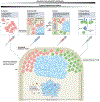Dynamics and specificities of T cells in cancer immunotherapy
- PMID: 37046001
- PMCID: PMC10773171
- DOI: 10.1038/s41568-023-00560-y
Dynamics and specificities of T cells in cancer immunotherapy
Abstract
Recent advances in cancer immunotherapy - ranging from immune-checkpoint blockade therapy to adoptive cellular therapy and vaccines - have revolutionized cancer treatment paradigms, yet the variability in clinical responses to these agents has motivated intense interest in understanding how the T cell landscape evolves with respect to response to immune intervention. Over the past decade, the advent of multidimensional single-cell technologies has provided the unprecedented ability to dissect the constellation of cell states of lymphocytes within a tumour microenvironment. In particular, the rapidly expanding capacity to definitively link intratumoural phenotypes with the antigen specificity of T cells provided by T cell receptors (TCRs) has now made it possible to focus on investigating the properties of T cells with tumour-specific reactivity. Moreover, the assessment of TCR clonality has enabled a molecular approach to track the trajectories, clonal dynamics and phenotypic changes of antitumour T cells over the course of immunotherapeutic intervention. Here, we review the current knowledge on the cellular states and antigen specificities of antitumour T cells and examine how fine characterization of T cell dynamics in patients has provided meaningful insights into the mechanisms underlying effective cancer immunotherapy. We highlight those T cell subsets associated with productive T cell responses and discuss how diverse immunotherapies might leverage the pre-existing tumour-reactive T cell pool or instruct de novo generation of antitumour specificities. Future studies aimed at elucidating the factors associated with the elicitation of productive antitumour T cell immunity are anticipated to instruct the design of more efficacious treatment strategies.
© 2023. Springer Nature Limited.
Conflict of interest statement
Figures




References
-
- Sharma P & Allison JP Dissecting the mechanisms of immune checkpoint therapy. Nat. Rev. Immunol 20, 75–76 (2020). - PubMed
-
- Alcover A, Alarcón B & Di Bartolo V Cell biology of T cell receptor expression and regulation. Annu. Rev. Immunol 36, 103–125 (2018). - PubMed
-
- Boon T, Coulie PG, Van den Eynde BJ & van der Bruggen P Human T cell responses against melanoma. Annu. Rev. Immunol 24, 175–208 (2006). - PubMed
Publication types
MeSH terms
Grants and funding
LinkOut - more resources
Full Text Sources
Medical
Miscellaneous

